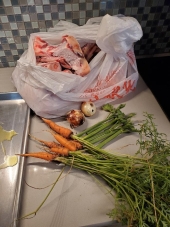I've joined a hunting group in my area and have helped with the processing of various animals. Just the other day after cleaning up an elk I was asked to get rid of the remaining skin, carcass, and bones by dropping off in the forest somewhere.
"Why not use it on your land?" I asked. "Every part of the animal is useful."
After a little bit of back and forth, the reply was basically something like this: "Don't tell anybody in our hunting group about your experimental methods. They will look at you like you are crazy."
I was trying to offer permaculture zero waste ideas and alternatives, rather than just throwing something useful away into the forest, but apparently this kind of stuff seems crazy to some people. Opposite sides of the eco-scale, I suppose.
So, I decided to not take the remains to the forest. Instead the elk remains, as well as any future throw away animal parts, are ending up in a large compost pile at my place. When time comes to harvest the compost there will likely be lots of bones to make use of. One of my issues is acidic soil (tested at 3.6), so...Problem to Solution! Calcium phosphate?
I found this thread
https://permies.com/t/216878/Bones to look for ideas, and came across this reply:
John Suavecito wrote:I dry out the bones, and then I throw them into the biochar when I burn it. I've read that it improves the biochar somehow.
John S
PDX OR
"
Seems to me like one of the easiest solutions for my situation is to throw the bones into a kon-tiki style pit. I will be making a huge amount of biochar soon with all the tree trimming materials ive been collecting over the last year, so might as well add the bones?
How exactly do the bones improve biochar?
If just charring the bones on their own, then is there a limit to how long and at what temperatures? How to get the most out of them with the least amount of inputs?










